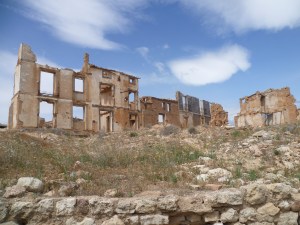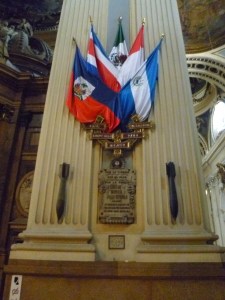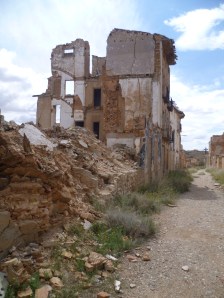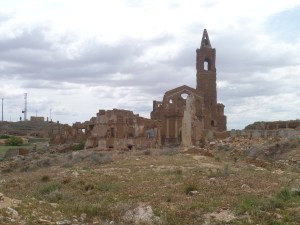The small town of Belchite in Aragon was reduced to rubble in the course of one of the bloodiest battles of the Spanish Civil War.
First taken by Republican troops on September 6 1937 it was won back by the Fascists in March 1938. General Franco ordered that it be left untouched – as a perpetual memorial to the wanton destruction wreaked by his enemies.
Walking around Belchite now is a chilling and moving experience. You don’t readily find it on official tourist trails and there are no interpretive facilities.
A few years ago, you could pick up empty cartridge cases. There is still the odd artillery shell sticking out from a wall.
It is difficult to walk away from Belchite without a desire to find out what happened there. This post is inevitably an incomplete sketch of the story – please leave a comment if you’ve something to add. Sources are shown in italics and listed at the end.
The historiography of the Spanish Civil War is marked by decades of suppression under the Franco regime followed by a flourishing in print, film and audio recordings.
More recently the web has brought a wealth of digital history – the recollections of those who took part. It has been a poignant swansong for those who served in the International Brigade, the volunteer army from nearly 50 countries who came to the aid of the Republic.
Franco’s revolt in July 1936 triggered appalling violence by both sides in communities across Spain. In Belchite, it was directed against the Republicans: 370 of its inhabitants (around one in ten of the population) were summarily shot- including the socialist mayor and even the village idiot. (Haslam).
The following month the sacred Our Lady of the Pilar Cathedral in nearby Zaragoza was bombed. Somewhat bizarrely, this is still commemorated with two of three bombs on prominent display near the main altar. What happened to the third bomb is not clear.
The battle for Belchite was part of the Aragon offensive by Republican troops to seize Zaragoza, command of the river Ebro and link up with anti- Fascist forces in the north.
Laurie Lee recalled the experience of an American volunteer captured near Belchite:
“The Aragon was a cock-up, the Yank said. No artillery, no plans, no timing, no leaders, everybody running around like rabbits. He was a machine gunner, had a beautiful Dichterer, too – only they gave him the wrong ammunition. That’s why he had his ass shot off. Lucky to be alive, none of his pals were left.
“They were surrounded ….. some Moors took his pals prisoner, and cut their throats, one by one; then they dropped him off a bridge and broke his legs.”
The International Brigades were used by the Republic as shock troops and Canadian, American and British brigaders bore the brunt of the assault and later defence of Belchite.
Fife miner Hugh Sloan recalled: (Gray)
“Belchite was a particular kind of battle at close quarters. You were seeing the person you were killing. That’s a different thing from killing people at a distance. In that respect it was a very bitter battle.
“I remember walking up what you could call the main street and I couldn’t bear the smell of death. Some of our people were digging large holes into which all sorts of remains of living things, humans but also pigs and goats, were being thrown.
“We came to the square. There was a very large heap of dead human beings piled up. And in the very hot weather the smell was completely unbearable.”
Irish-American Bill Bailey was also there: (Spartacus)
“We would knock a hole through a wall with a pickaxe, throw in a few hand grenades, climb through into the next house, and clear it from cellar to attic. And, by God, we did this hour after hour.
“The dead were piled in the street, almost a storey high, and burnt. The engineers kept pouring on gasoline until the remains sank down. Then they came with trucks and swept up the ashes. The whole town stank of burning flesh.”
A range of websites like Porta de la Historia have fuelled renewed interest in the war. Ciaran Crossley’s excellent site offers source material on the Irish Brigaders and the Irish contingent led by Eoin O’Duffy who briefly fought on the other side.
Leonard Lamb, another American volunteer recalled: (Spartacus)
“Belchite – the stinkingest town I was ever in… we had to storm that stupid, stupid town against tremendous odds and many of our people were killed because it had been announced – by the War Ministry – that Belchite had been captured.”
Paul White also served in the Abraham Lincoln battalion and told his court martial: (Spartacus)
“After Belchite I knew I was afraid to go into action again. I tried all this time to overcome my feeling of fear. I felt we were doomed and fighting futilely. I dropped out of line and made up my mind to desert and try and reach France.” White was later executed by his commanders for desertion.
The Nationalist defenders put up a valiant and stubborn resistance for several days – the exhausted remnants running out of food and water finally surrendered. It is still not clear how many were killed in the battle.
Paddy Cochrane, an Irish volunteer in a Republican ambulance unit was badly wounded by a grenade. (Curiously, he had a namesake in another ambulance unit – Archie Cochrane, a Scottish medical student, who became the father of evidence- based medicine: the international Cochrane Collaboration is named after him).
Paddy had seen his father shot dead by the Black and Tans when he was seven. He returned to Belchite on the 70th anniversary hoping to find out more about the big American who save his life. The journey was poignantly chronicled by Sunday Times journalist Chris Haslam.
Republicans celebrated the victory but their elation was short lived. They never reached Zaragoza and Belchite was retaken on March 10, 1938 in another grisly battle.
Priscilla Scott-Ellis, a British nurse working for the Nationalists, helped clear rubble and scrubbed floors to establish an operating theatre.
Queuing for water at a fountain, she was told that there were eighty-five prisoners of the International Brigades nearby, mostly Americans but also some English. “They will all be shot as foreigners always are” she noted in her diary. (Preston)
Later, and apparently indifferent to the fate of her fellow countrymen, she added: “I have never enjoyed a day more but have never been dirtier.”
A Manchester Guardian report on March 12 referred to the defence mainly by soldiers of the International Brigade, the majority of whom were Canadians. About 100 were taken prisoner.
Various nationalities, including Canadians and Americans, often fought in the same units. Their fate is not clear.
One man stayed back, rejecting the call to retreat. Barney Shields, from Glasgow, was a former British Army soldier in India and a proficient marksman. He took his machine gun up the bell tower in the church to give covering fire for his comrades. He was thus the last brigader standing in Belchite until he was flushed out and killed (Gray).
Memories of the civil war are still raw in Spain and, as Ritchie Calder once told the House of Lords, “Memory has long knives ….and history books sharpen them.”
But Belchite is not simply a Spanish matter nor will it ever be. Around 9000 volunteers like Barney came to Spain and did not go home. The Brigades were truly International.
Sources
Laurie Lee, A Moment of War War, Viking, 1991.
Daniel Gray, Homage to Caledonia, Luath, Edinburgh, 2008.
Spartacus has excellent sources on on the Spanish Civil War and the battle of Belchite.
So too has the Abraham Lincoln Brigade Archives
Ciaran Crossley’s Ireland SCW site is a real treasure
Paul Preston, Doves of War, Four Women of Spain, Harper Collins, 2002
Chris Haslam’s piece on Paddy Cochrane’s return to Belchite
There are a couple of references to Barney Shields in the Imperial War Museum’s audio archive which it is seeking to make available online. It is also developing an online poster collection of the Spanish Civil War with the Biblioteca Naçional de España.
Categories: case studies, digital history, history on the web





amazing stuff , thought i knew a bit about Spanish Civil War ……… now realise I know next to nothing. A real eye opener
Great article about one of the lesser known battles – can we post on Books4Spain? We have a Theme dedicated to Spanish Civil War “Great range of titles and most comprehensive listing I have seen of books in print relating to the Civil War.” Martin Ellis Zymurgy Publishing http://books4spain.com/viewtheme/index/13
Books include this one which has articles on Belchite: http://books4spain.com/book/detail/articles-on-battles-of-the-spanish-civil-war-including-1
The Olive Groves of Belchite is unfortunately out of print (I know the author).
Also, reviews of many Civil War related books on our blog: http://books4spain.com/blog/?cat=880 and an article by me re Underlying Causes of Spanish Civil War.
Thanks Rod. Yes, by all means link or reblog the post.. Have looked at books4spain and your links. Very interesting and will look further.
Many thanks Chris – yes let me know if you want to put links to our Spanish Civil War books on your blog. Are you interested in doing any reviews of Civil War related books? On a separate note, as you may have gathered from my name I do have Scottish roots – 3 Younger brothers went to Jamaica in 1700s and then one of their sons came to Spain in 1814. On the Spanish side my grandfather fought for Nationalist in Civil War but was one of the first soldiers killed just outside Madrid in July 1936 – he is actually profiled in Spanish Civil War Heroes book put out by Nationalists. Quite a lot of similar history in the family going back to Peninsular War and Carlists Wars!
Thanks for this insight into Belchite. Barney Shields whom my grand-father and young mother knew from their pre-blitzed Clydebank, was (according to the stories they told me as a boy) a larger than life character. Barney went to Spain with the support of the poor working class people who were struggling against very harsh economic times. I came across this article indirectly when looking at some Catalan Independence links received on twitter.
thanks again
Hi David – if you are interested in learning more about Spanish Civil War http://www.Books4Spain.com has a Theme dedicated to Spanish Civil War “Great range of titles and most comprehensive listing I have seen of books in print relating to the Civil War.” Martin Ellis Zymurgy Publishing http://books4spain.com/viewtheme/index/13
Books include this one which has articles on Belchite: http://books4spain.com/book/detail/articles-on-battles-of-the-spanish-civil-war-including-1
Also, reviews of many Civil War related books on our blog: http://books4spain.com/blog/?cat=880 and an article by me re Underlying Causes of Spanish Civil War.
We are currently reviewing I am Spain by David Boyd Haycock – a new book which traces Spanish Civil War through a number of british volunteers. http://books4spain.com/book/detail/i-am-spain-2
Reblogged this on readinggivesmewings and commented:
Just started Reading up on the Spanish Civil War…This is a great Blog post on it.
What Franco wanted us to see…… | The History Company Os adrezco el compartir con todos nosotros toda esta amena información. Con estos granitos de arena hacemos màs grande la montaña Internet. Enhorabuena por este blog.
Niice blog